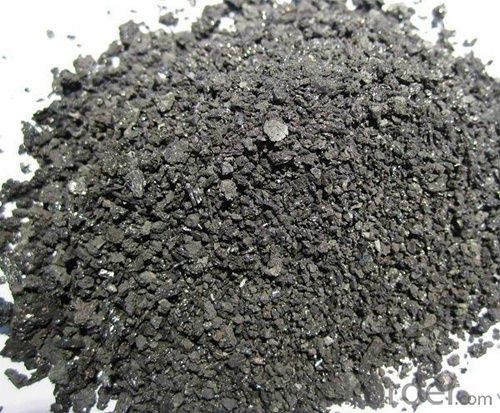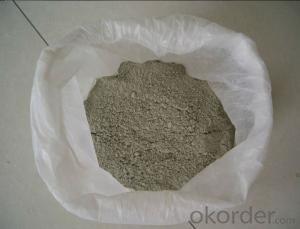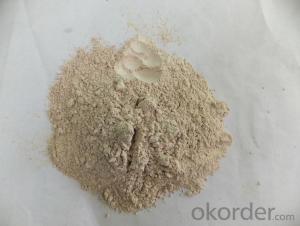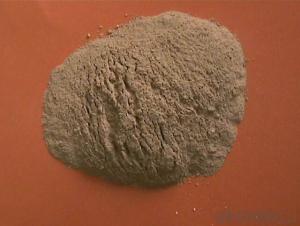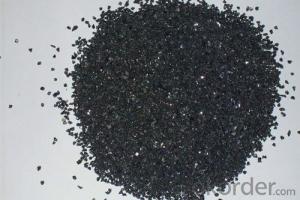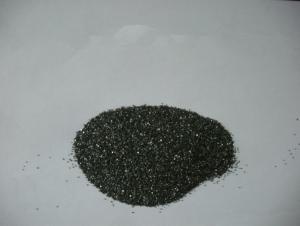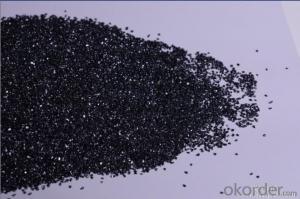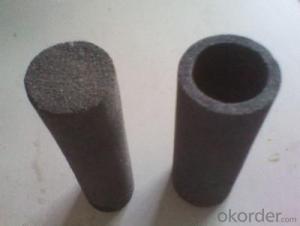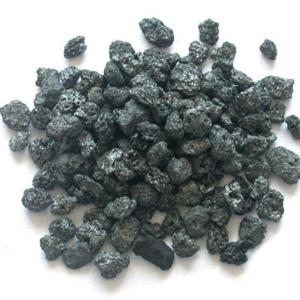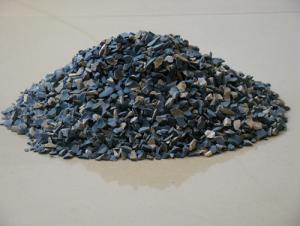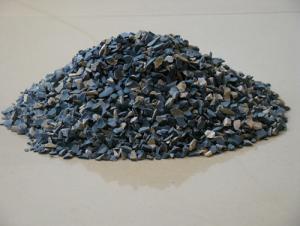Raw Materials for Refractory:Abrasive Black Silicon Carbide/Carborundum Grit
- Loading Port:
- China main port
- Payment Terms:
- TT OR LC
- Min Order Qty:
- 25 m.t.
- Supply Capability:
- 2000 m.t./month
OKorder Service Pledge
OKorder Financial Service
You Might Also Like
Product Description
Product name | Abrasive black silicon carbide/Carborundum |
Model No | BA-#20 |
Brand name | CNBM |
Description |
|
Advantage |
|
Parameter |
|
Usage |
|
Shipping way | By sea, by air, by express |
Delivery time | Within 7 days from the receipt of payment |
Loading seaport | Shenzhen |
Package | 25kg/bag with woven bag |
Price term | FOB Shenzhen, CFR,, CIF, FCA, EXW ect |
Payment term | 100% T/T in advance(negotiation) |
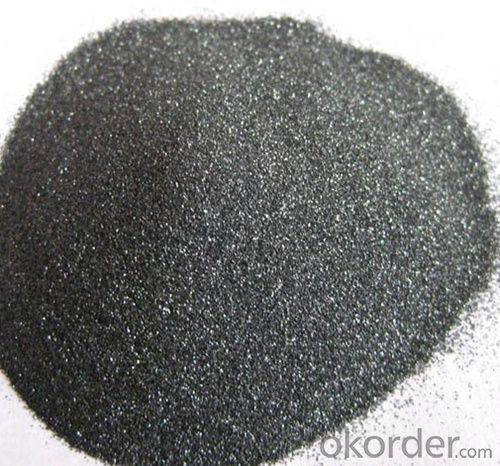
- Q: How long usually will the A-level fireproof materials prevent the flame?
- A-level fireproof materials refer to the materials which are made of non-combustible materials, it is a different concept from fire resistance. non-combustible elements: Components are made of non-combustible materials. Non-combustible materials refer to materials that will not burst into flame, and burn as well as be carbonized when affected by fire and high temperature in the air. Fire resistance: Having a fire resistance test on any building components -----according to the standard time-temperature curve. This period starts from the time when affected by fire and ends up with losing the ability to support or to insulate fire or the integrity of the components. It can be expressed in hours.
- Q: What antioxidant will be used in refractories?
- Antioxidant: Si, Al, Mg, Ti, AlSi, AlMg, SiC, TiC, ZrC and these metal nitride, boride. Sintering agent: different mechanism, Cr2O3 to promote the sintering of alumina;CaO/MgO style promote ZrO sintering;Siliceous ramming material to add boron bottles, magnesia coating and clay, etc.
- Q: What's the poured refractory material?
- According to its category, raw material of basic refractory: Mainly magnesite (magnesia), dolomite, lime, olivine, serpentine, high alumina material (sometimes neutral); main neutral raw material: chromite, graphite, silicon carbide (artificial).
- Q: How to make use of waste refractory materials whose main elements are alumina and mullite?
- Crushing and pressing refractory bricks, or refractory parts . Such as welding positioner tracks use disposable tools.
- Q: I would like to ask a friend that how much is the fire endurance of level A fireproofing glass?
- fireproofing glass is mainly control the spread of fire or smoke insulation, and is a measurable fireproofing material, the fireproofing effect is evaluated by the fire resistance. It is through a special process and treatment, and it is a special glass which can maintain its integrity and thermal insulation in the specified fire resistance test. Original glass of fireproofing glass can be used float flat glass, and composite fireproofing glass also can use monolithic fireproofing glass.
- Q: what is the fireproofing material of engine room? who knows it ?
- machine room fireproofing materials include: Inorganic binder: The main material includes sodium silicate, gypsum, phosphates, cement,ect.; refractory mineral filler: aluminium oxide, asbestos powder, calcium carbonate, perlite, cornstarch, ect.; nonflammable organic resin: it mainly includes polyvinyl chloride, perchloro-ethylene, chlorinated rubber, neoprene latex, epoxy resin, phenol resin, ect.. nonflammable fireproof addictive: it mainly has phosphorus, halogens, nitrogen organic compounds (chlorinated paraffins, tributyl phosphate,deca-brominated diphenyl ether), and boron series (boric acid, zinc borate, aluminium borate), antimony system, aluminium series, zirconium system, etc. inorganic compounds.
- Q: Development trend of refractory industry
- In the central provinces in Henan, Shanxi, Liaoning China main manufacturer of refractory material, which is the main origin of three China bauxite, magnesite and other refractory materials; refractories industry by the end of May 2009 more than 3236 enterprises; industry revenue reached 67 billion 52 million 540 thousand yuan, Henan Province, Liaoning, Shandong, Jiangsu, Hebei and other regions, and refractories industry in the development of better leading enterprises, such as blue and white, accessible, prco etc. at present, its sales in the industry in the proportion is still small, the largest sales is also inadequate in refractory industry in 4%. An enterprise should play a leading role in leading enterprises in the industry, and its turnover in the industry should be more than 15%. Obviously, at present the refractory industry in the leading enterprises do not have, and the refractory industry concentration needs to be improved, and the existing resources in the refractory industry integration, is undoubtedly the way this process effective and efficient.
- Q: What's the fire resistance test method of doors and roller shutters?
- Fire resistance test method of doors and roller shutters: This standard specifies the fire resistance test method for roller shutter doors under standard fire conditions. The method is used to test the fire resistance of the ventilating duct when bearing the external fire (A duct) and internal fire (B duct). Fire resistance test of vertical ducts may be conducted referring to this standard. 1.Test specimen1.1 The test specimen is obtained by cutting from any part of the qualified metal tube unless otherwise relevant standard or mutual agreement specifies the cutting position of the metal tube. 1.2 Length of the specimen: L≈2.5D+50mm (D: outer diameter of the metal tube). The cut surface of the specimen must be perpendicular to the axis of the metal , and the seamed edge of the cut should be round off. Test method GB243-82 of metal tube necking 2. Test procedures 2.1 In the test, punch or press the metal tube into the tapered conical seat (see Figure) with a hammer or press machine, and make it uniformly diminished to the regulated shrinkage X which is calculated according to the following formula: Test method GB243-822 for metallic pipe necking: The inner wall of the seat cover used in the test should be polished, and has certain hardness and is coated with lubricating oil. Its conicity is 1:10, 1:5 or others in accordance with relevant standard provisions. If there is no provision, then adopt the conicity of 1:10. This standard is not suitable for: a) The pipeline whose fire resistance depends on the fire resistance of the ceiling; b) The pipeline with access door, unless otherwise the access door is included into the pipeline and tested together; c) The pipeline with two or three sides; d) Fume exhaust pipes;
- Q: I am a refractory material manufacturer, sold products, money is always not back, anxious to die, what is the way?
- Many manufacturers are facing the same problem, difficult to find the order, order the payment contract is more difficult, it is difficult to have binding, the better solution is to seek third party secured transactions, see the whole production or see full delivery
- Q: What are the uses of refractory materials of glass furnace?
- crown--high-purity silica bricks; wall--melting end 41# fused zirconia corundum bricks with no shrinkages(41% of zirconium, similarly hereinafter), cooling end 33# fused zirconia corundum bricks with no shrinkages; bottom--33# fused zirconia corundum bricks(with shrinkages); breastwork--33# fused zirconia corundum bricks(with shrinkages); port--33# fused zirconia corundum bricks(with shrinkages); regenerator chamber--the upper part is for magnesite-chrome bricks, the bottom part is for high-duty fireclay bricks; checker--the upper part is for high purity magnesia bricks, and the bottom part is for magnesite-chrome bricks; flue--clay bricks. This is the best configuration. If the funds are limited, the configuration can be lowered, for example, the wall will be changed to 38 #......
Send your message to us
Raw Materials for Refractory:Abrasive Black Silicon Carbide/Carborundum Grit
- Loading Port:
- China main port
- Payment Terms:
- TT OR LC
- Min Order Qty:
- 25 m.t.
- Supply Capability:
- 2000 m.t./month
OKorder Service Pledge
OKorder Financial Service
Similar products
Hot products
Hot Searches
Related keywords



